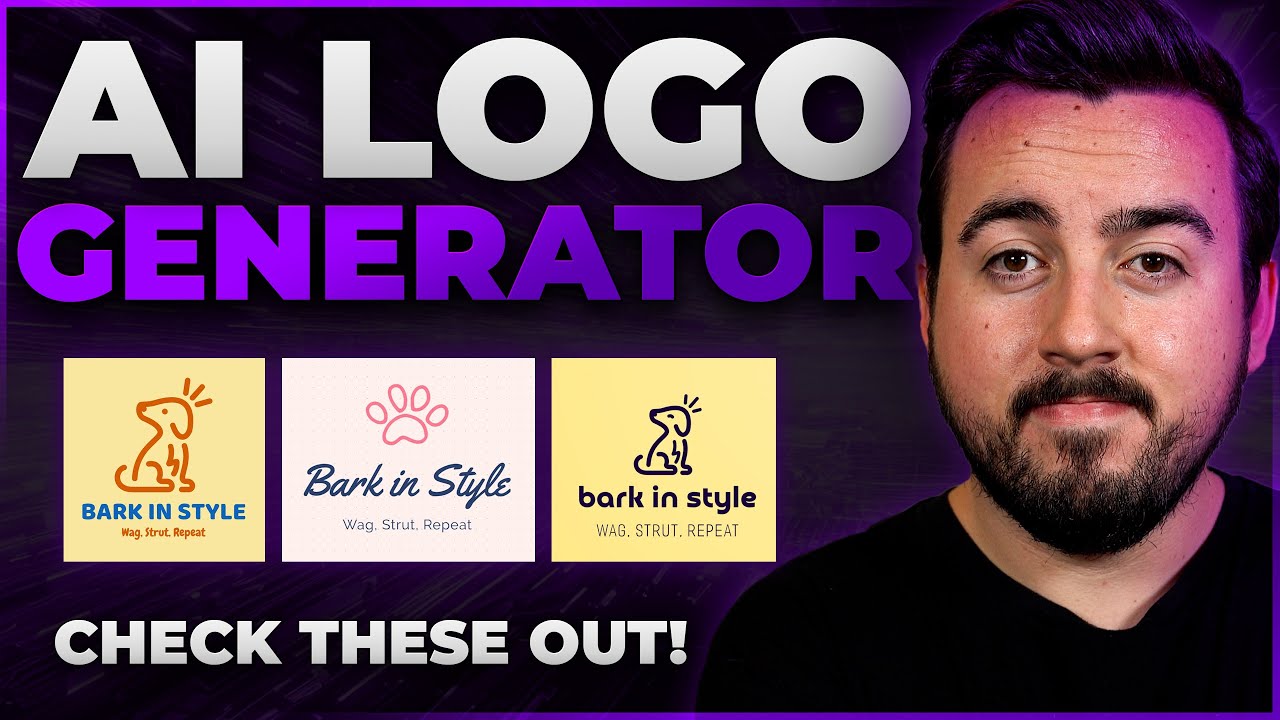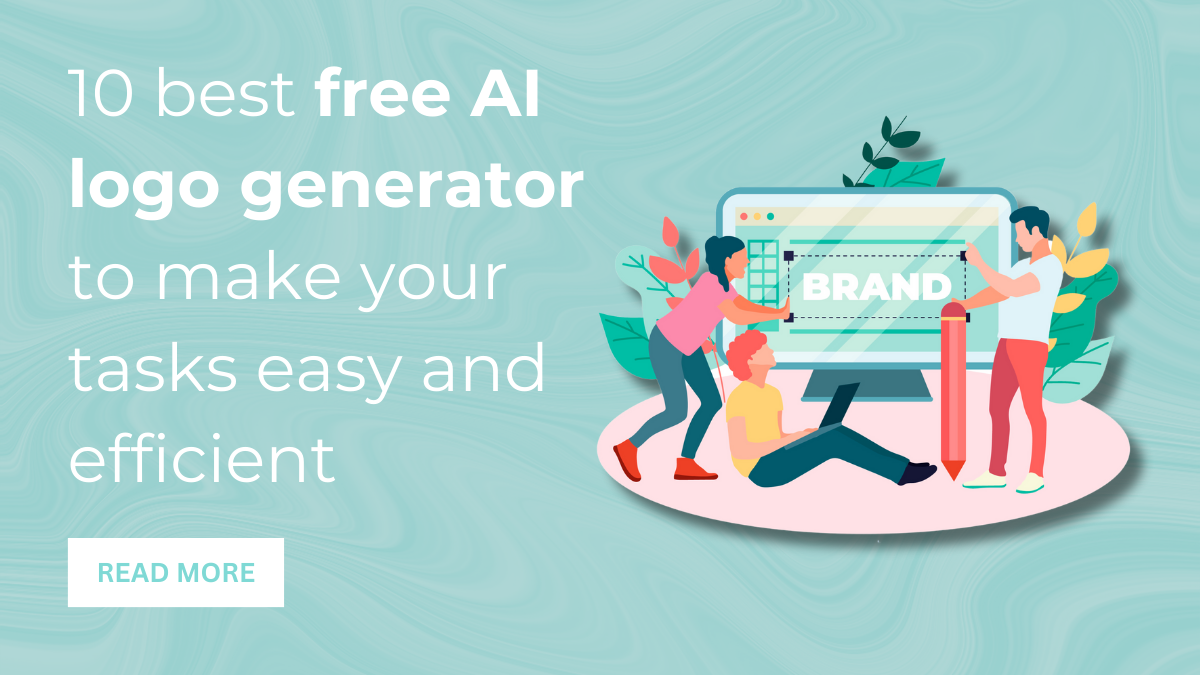The integration of
Artificial Intelligence (AI) in design, particularly in logo creation, is a groundbreaking advancement in the field of graphic design. AI transforms the design process by incorporating intelligent algorithms that can analyze data, learn from inputs, and make decisions, leading to innovative and efficient design solutions. Understanding the fundamentals of AI in design is crucial for leveraging its full potential.
Core Components of AI in Design:- Machine Learning: AI systems use machine learning to understand design patterns and preferences. Over time, these systems learn from the data inputted, allowing them to create more refined and suitable designs.
- Neural Networks: Mimicking the human brain, neural networks in AI analyze and process large amounts of data, recognizing complex patterns and relationships within the design elements.
- Natural Language Processing (NLP): This aspect of AI understands human language inputs, making it easier for designers to communicate their ideas to the AI tool.
How AI is Applied in Design:- Automated Design Generation: AI can quickly generate multiple design options based on specified criteria, significantly speeding up the initial design phase.
- Personalization: AI tools can tailor designs to individual preferences or brand identity, ensuring each logo is unique and resonant with its intended audience.
- Data-Driven Decisions: AI can analyze current design trends and user feedback, aiding in the creation of logos that are not only aesthetically pleasing but also effective in communication.
Benefits of AI in Design:| Benefit | Description |
|---|
| Efficiency | Reduces time spent on the conceptual and creation phases of design. |
| Creativity | Offers unique combinations and ideas that might not be immediately obvious to human designers. |
| Scalability | Easily handles large-scale projects or variations of a design. |
| Customization | Provides highly personalized designs based on user inputs. |
| Cost-Effectiveness | Reduces labor costs and resources associated with traditional design processes. |
In conclusion, understanding AI's role in design is pivotal for modern designers and businesses looking to stay ahead in the competitive world of branding and visual communication. By harnessing the power of AI, the process of logo creation becomes more dynamic, intuitive, and aligned with the rapidly changing design trends.
The Rise of AI Image Generators

The advent of
AI image generators marks a significant milestone in the digital and creative industries. These tools, powered by advanced artificial intelligence technology, have transformed the way images, including logos, are created, edited, and refined. The rise of AI image generators is attributed to several factors, which collectively have redefined the landscape of graphic design and visual content creation.
Key Factors Behind the Popularity of AI Image Generators:- Technological Advancements: Continuous improvements in AI and machine learning algorithms have made these tools more sophisticated and capable of generating high-quality images.
- User-Friendly Interfaces: Many AI image generators offer intuitive interfaces, making them accessible to both professionals and amateurs without requiring advanced design skills.
- Time and Cost Efficiency: These tools significantly reduce the time and cost associated with traditional image creation methods, making them a popular choice for businesses and individual creators.
- Customization and Flexibility: AI image generators provide a high level of customization, allowing users to create unique and tailored images based on specific inputs and preferences.
Impact of AI Image Generators on the Design Industry:| Aspect | Impact |
|---|
| Creativity | Enhances creative possibilities with novel and unique image compositions. |
| Efficiency | Streamlines the design process, from conceptualization to final output. |
| Accessibility | Makes high-quality design more accessible to a broader audience. |
| Innovation | Encourages continuous innovation in digital art and design techniques. |
Popular Use Cases of AI Image Generators:- Logo Design: AI-driven tools are increasingly being used to create unique and compelling logos.
- Marketing and Advertising: AI generators assist in producing visually striking graphics for marketing campaigns.
- Web and App Development: They provide quick and tailored images for website and app interfaces.
- Art and Illustration: Artists and illustrators are using AI to explore new artistic expressions and styles.
In summary, the rise of AI image generators symbolizes a paradigm shift in the realm of digital design and content creation. Their ability to blend creativity with efficiency has made them a cornerstone tool in various industries, pushing the boundaries of traditional design practices.
Step-by-Step Guide to Creating Your AI-Generated Logo
Creating a logo using AI technology is a straightforward and efficient process. This step-by-step guide will walk you through creating an AI-generated logo, ensuring you can harness the power of artificial intelligence to develop a unique and professional brand identity.
Step 1: Choose the Right AI Logo Generator- Research and select an AI logo generator that fits your needs. Consider factors like ease of use, customization options, and cost.
Step 2: Input Your Brand Details- Enter specific details about your brand, such as your company name, industry, and any tagline.
- Provide information about your brand's personality and the message you want to convey with your logo.
Step 3: Select Your Preferences- Choose color schemes, fonts, and style preferences that align with your brand identity.
- Some AI tools may also ask for logo types or symbols you prefer to include in your design.
Step 4: Generate Logo Options- Once you have input all the necessary details, the AI tool will generate several logo options for you to review.
Step 5: Review and Customize- Examine the generated logos and select the one that best fits your brand.
- Make adjustments to fine-tune the design, such as modifying color palettes, typography, or layout.
Step 6: Finalize and Download- Once you are satisfied with the design, finalize your logo.
- Download the logo in various formats suitable for different uses (web, print, merchandise).
Additional Tips:- Be Clear With Your Brand Identity: Having a clear understanding of your brand identity will guide the AI to produce more relevant results.
- Experiment With Different Options: Don't hesitate to generate multiple logos and explore various combinations before settling on the final design.
- Seek Feedback: Before finalizing, get feedback from team members or your target audience to ensure the logo resonates well.
In conclusion, creating an AI-generated logo is a process that combines technology with creativity. By following these steps, you can effectively leverage AI to produce a logo that not only stands out but also truly represents your brand's essence.
Benefits of Using AI for Logo Design
Utilizing AI for logo design offers a myriad of advantages that can transform how businesses and individuals approach brand identity creation. From enhanced creativity to unparalleled efficiency, the benefits of AI in logo design are vast and impactful.
1. Efficiency and Speed- AI drastically reduces the time required to design a logo, allowing for rapid generation and iteration of design ideas.
- Instantly produces multiple design options, providing a wide array of choices in a fraction of the time it would take a human designer.
2. Cost-Effectiveness- Reduces the need for extensive human labor, which can be a significant saving, especially for small businesses or startups.
- Most AI logo design tools are more affordable than hiring a professional designer, making quality logo design accessible to all budget levels.
3. Customization and Flexibility- AI tools offer a high level of customization, allowing users to create a logo that truly reflects their brand’s identity.
- Easy to modify and tweak designs as per specific requirements or feedback.
4. Data-Driven Insights- AI algorithms can analyze current trends and consumer preferences, ensuring the logo design is not only visually appealing but also relevant and effective.
5. No Design Skills Required- AI logo design tools are user-friendly and do not require any prior design knowledge or experience.
- Empowers non-designers to create professional-quality logos without the steep learning curve associated with traditional design software.
6. Innovative Design Options- AI can suggest unique combinations and creative designs that might not be immediately apparent to human designers.
- Encourages experimentation with styles, colors, and typography, leading to innovative logo designs.
ConclusionThe benefits of using AI for logo design are transformative, offering a blend of efficiency, accessibility, and creativity. This technology is not only reshaping the design process but is also democratizing logo design, making it possible for anyone to create a logo that is both professional and personal to their brand identity.
Comparing AI-Generated Logos with Traditional Design Methods
The evolution of logo design has been significantly influenced by the advent of AI technology. Comparing AI-generated logos with traditional design methods reveals distinct differences in process, creativity, and outcomes. Each approach has its unique strengths and considerations.
Process and Time Efficiency | AI-Generated Logos | Traditional Design |
|---|
| Speed | Fast generation of multiple designs. | Longer process involving extensive human effort. |
| Customization | Highly customizable with instant revisions. | Customization is manual and time-consuming. |
| User Involvement | Minimal design skills required; user-friendly interfaces. | Requires professional skills or hiring a designer. |
Creativity and Originality- AI-Generated Logos: AI can create unique designs by combining vast datasets and patterns. However, there's a potential risk of creating generic logos if the AI's learning base is not diverse or innovative enough.
- Traditional Design: Human designers bring personal creativity and experience, ensuring originality and a unique touch. However, the creative process can be limited by individual experience and current trends.
Cost Implications- AI-Generated Logos: Generally more cost-effective due to automated processes. Ideal for startups or businesses with limited budgets.
- Traditional Design: Involves higher costs due to the labor and time of skilled designers. However, this can be a worthwhile investment for bespoke, high-quality designs.
Quality and Brand Alignment- AI-Generated Logos: Quality can vary depending on the sophistication of the AI tool. AI might not fully grasp the nuances of brand identity without human insight.
- Traditional Design: Professional designers can ensure that the logo aligns well with the brand’s ethos and story, offering a more personalized approach.
ConclusionWhile AI-generated logos offer speed, efficiency, and affordability, traditional design methods provide uniqueness, personal creativity, and a deep understanding of brand narrative. The choice between the two methods depends on specific project requirements, budget constraints, and the desired level of originality and personalization in the logo design.
Best Practices and Tips for Designing AI Logos
Designing logos with AI tools can be an innovative and efficient process. However, to maximize the effectiveness of these tools, it's important to follow certain best practices and tips. These guidelines can help ensure that the logos not only look professional but also align well with your brand's identity and values.
1. Define Your Brand Identity Clearly- Before starting with an AI tool, have a clear understanding of your brand's core values, mission, and target audience.
- This clarity helps in providing accurate and detailed inputs to the AI, leading to more relevant and effective logo designs.
2. Be Specific with Your Inputs- The more specific you are with your inputs (like color preferences, industry type, brand personality), the more tailored the AI’s output will be.
- Use descriptive keywords and phrases to guide the AI towards your desired outcome.
3. Explore Various Design Options- Take advantage of the AI’s capability to generate multiple designs quickly and explore a variety of options.
- This exploration can provide unexpected but excellent design ideas that might not have been considered otherwise.
4. Customize and Refine- Once you have a base design, use the AI tool’s customization features to tweak and refine the logo.
- Adjust elements like fonts, colors, and layout to perfectly align with your brand's aesthetic.
5. Ensure Scalability and Versatility- Make sure your logo looks good in different sizes and across various mediums, from digital to print.
- A versatile logo will maintain its integrity and effectiveness in all forms of brand representation.
6. Seek Feedback- Once you have a draft, get feedback from stakeholders, potential customers, or a professional designer.
- This feedback can provide critical insights and perspectives that you might have missed.
7. Stay Updated with Design Trends- While originality is key, being aware of current design trends can help ensure your logo remains relevant and appealing.
ConclusionDesigning a logo using AI requires a balance between technology and human insight. By following these best practices and tips, you can effectively leverage AI to create a logo that is not just visually appealing but also a true embodiment of your brand's identity and ethos.
Future Trends in AI and Graphic Design
The intersection of AI and graphic design is an area ripe for continuous innovation. As AI technology evolves, it is set to redefine the landscape of graphic design in numerous ways. Here are some key trends that are expected to shape the future of this exciting field.
1. Advanced Personalization- AI systems will become more adept at creating designs that are highly personalized to individual brand needs, customer preferences, and even cultural contexts.
- This will lead to more effective and targeted visual communications.
2. Enhanced Creative Collaboration- AI tools are expected to evolve from being just tools to collaborative partners, offering suggestions and alternatives that complement human creativity.
- This collaboration will push the boundaries of innovation in design.
3. Real-time Design Adaptation- AI will enable designs that can adapt in real-time based on data inputs like user interactions, environmental changes, or market trends.
- Such dynamic designs will revolutionize how brands interact with their audience.
4. Learning and Evolving Design Systems- Future AI systems will be capable of learning from each project, becoming more efficient and intuitive with each design task they perform.
- This continuous learning will lead to increasingly sophisticated design outputs.
5. Accessibility and Democratization of Design- AI will make high-quality design more accessible to non-designers, democratizing the ability to create engaging visuals.
- This will empower more people to bring their ideas to life without the need for extensive design training.
6. Ethical and Sustainable Design- As AI becomes more prevalent, there will be a greater emphasis on ethical design practices and sustainable methodologies.
- AI will aid in creating designs that are both environmentally conscious and socially responsible.
ConclusionThe future of AI in graphic design is not just about automation, but about augmentation and enhancement of human creativity. These trends indicate a shift towards more personalized, collaborative, and responsible design practices, reshaping how we conceive and interact with visual content.
FAQ
Q1: Can AI completely replace human graphic designers?
A1: While AI significantly enhances efficiency and offers innovative design solutions, it cannot fully replace human creativity and intuition. AI is best used as a tool to complement and augment the skills of human designers.
Q2: Are AI-generated logos unique?
A2: AI-generated logos can be unique, especially if the AI tool is fed with specific and detailed input. However, the uniqueness also depends on the complexity and learning capabilities of the AI system.
Q3: Do I need design skills to use AI logo generators?
A3: No, one of the main advantages of AI logo generators is their user-friendliness, allowing individuals without design skills to create professional-looking logos.
Q4: How does AI ensure my logo aligns with my brand identity?
A4: AI tools analyze the information and preferences you provide about your brand. The more detailed your input, the more aligned the output will be with your brand identity.
Q5: Is it expensive to use AI for logo design?
A5: Generally, using AI for logo design is more cost-effective than hiring a professional designer, making it a viable option for businesses of all sizes, especially startups and small enterprises.
Q6: Can AI design logos in any style?
A6: Most AI logo design tools offer a range of styles and customization options. However, the range of styles depends on the tool’s capabilities and the diversity of its learning database.
Q7: How do I choose the best AI logo design tool?
A7: Consider factors like ease of use, customization options, design styles offered, and user reviews. Also, evaluate whether the tool meets your specific needs and budget.
Q8: Can I trademark an AI-generated logo?
A8: Yes, you can trademark an AI-generated logo as long as it meets the necessary criteria for trademark registration, such as being distinctive and not infringing on existing trademarks.
Conclusion
The integration of AI in the realm of logo design heralds a new era in graphic design, characterized by efficiency, innovation, and accessibility. As we have explored, AI logo creation offers a plethora of advantages, from time-saving and cost-effectiveness to the ability to generate a wide range of design options. This technology, while not a replacement for human creativity and expertise, stands as a powerful tool that democratizes design and opens up new possibilities for businesses and individuals alike.However, the use of AI in design also brings forth considerations regarding the uniqueness and personal touch of a logo. It's important to remember that the most effective use of AI in logo creation lies in its collaboration with human input and creativity. By understanding the strengths and limitations of AI and following best practices, users can harness this technology to produce logos that are not only visually appealing but also deeply resonant with their brand identity.As we look to the future, the evolving landscape of AI in graphic design promises even more advanced capabilities. This progression will undoubtedly continue to transform how we conceive and execute design projects, making it an exciting time for both seasoned designers and newcomers to the field. Embracing AI in logo design is not just about keeping up with technology; it's about unlocking new creative potentials and redefining the boundaries of what's possible in graphic design.
 The advent of AI image generators marks a significant milestone in the digital and creative industries. These tools, powered by advanced artificial intelligence technology, have transformed the way images, including logos, are created, edited, and refined. The rise of AI image generators is attributed to several factors, which collectively have redefined the landscape of graphic design and visual content creation.Key Factors Behind the Popularity of AI Image Generators:
The advent of AI image generators marks a significant milestone in the digital and creative industries. These tools, powered by advanced artificial intelligence technology, have transformed the way images, including logos, are created, edited, and refined. The rise of AI image generators is attributed to several factors, which collectively have redefined the landscape of graphic design and visual content creation.Key Factors Behind the Popularity of AI Image Generators:
 admin
admin








